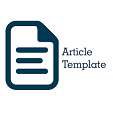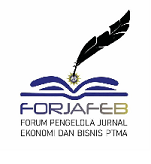FRAUD DIAMOND TERHADAP FINANCIAL STATEMENT FRAUD
Abstract
This study aims to examine the effect of diamond fraud on financial statement fraud: an empirical study in the west kalimantan province, both partially and simultaneously. Fraud can occur in every country with different types and frequencies, because there are still potential risks of corruption in the political system that hasn’t changee. In addition, there are indications of suspicious relation between politicians and business people who explain that bribery and corruption are still present in the indonesian political system.
Fraud Diamond’s research results on the financial statement fraud: empirical study in west kalimantan, shows that partially external presure and opportunity affect the financial statement farud, while rationalization and capability doesn’t affect the financial statement fraud. In addition, simultaneously external presure, rationalization, opportunity, and capability affect the financial statement fraud of 86,4%, while the remaining 13,6% is influence by other variables not examine in this studyKeywords
Full Text:
PDFReferences
Amrizal, Ak. MM, CFE. (2004). Pencegahan dan Pendeteksian Kecurangan Oleh Internal Auditor
Andilala. (2017). Pontianak Peringkat Kedua Indeks Persepsi Korupsi SeIndonesia. [Online] tersedia : http://kalbar.antaranews.com/berita/357769/pontianak-peringkat-keduaindeks-persepsi-korupsi-se-indonesia (24 Mei 2019)
Annisya, Mafiana., et all. (2016). “Pendeteksian Kecurangan Laporan Keuangan Menggunakan Fraud Diamond”. Jurnal Bisnis dan Ekonomi (JBE), Maret 2016, Hal. 72 – 89.
Charles, Nenyiaba Ile dan Okoye Emma. (2015). “Evaluation of Key Determinants of Fraud Free Financial Report: a Focus on Nigeria”. Business and Management Studies,Vol.1, No.2.
Hariyanto, Ibnu. (2017). ICW : Dalam 6 Bulan, 226 Kasus Korupsi Rugikan Negara Rp 1,83 T. [Online] tersedia : http://m.detik.com/news/berita/d-3621894/icwdalam-6-bulan-226-kasus-korupsi-rugikan-negara-rp-183-t (24 Mei 2019)
Indriani, Poppy dan M. Titan Terzaghi. (2017). “Fraud Diamond Dalam Mendeteksi Kecurangan Laporan Keuangan”. I-Finance Vol. 3. No. 2.
Jensen, Michael C. Dan William H. Meckling. (1976). “Theory of the Firm: Managerial Behavior, Agency Costs and Ownership Structure”. Journal of Financial Economics, V. 3, No. 4, pp. 305-360.
Liana, Lie. (2009). “Penggunaan MRA dengan SPSS untuk Menguji Pengaruh Variabel Moderating terhadap Hubungan antara Variabel Independen dan Variabel Dependen”. Jurnal Teknologi Informasi DINAMIK, 14(2), h: 90-97.
Pamungkas, Ridwan Putra. (2018). “Deteksi Kecurangan Pelaporan Keuangan Dengan Teori Fraud Diamond Pada Laporan Keuangan Pemerintah Daerah”. Skripsi. Bandar Lampung : Fakultas Ekonomi dan Bisnis Universitas Lampung.
Peraturan Badan Pemeriksa Keuangan Republik Indonesia Nomor 1 tahun 2017 tentang Standar Pemeriksaan Keuangan Negara
Peraturan Pemerintah RI Nomor 60 Tahun 2008 tentang Sistem Pengendalian Intern Pemerintah
Peraturan Pemerintah RI Nomor 71 Tahun 2010 tentang Standar Akuntansi Pemerintah
Purwanto, Edy., et all. (2017). “Kajian Konsep Diamond Fraud Theory Dalam Menunjang Efektivitas Pengadaan Barang/Jasa Di Pemerintah Kota Bogor”. Jurnal Manajemen Indonesia, Vol.17 No.3.
Puspitadewi, Esterine dan Partogian Sormin. (2016). “ Pengaruh Fraud Diamond Dalam Mendeteksi Financial Statement Fraud (Studi Pada Perusahaan Manufaktur Yang Terdaftar Di Bursa Efek Indonesia Tahun 2014-2016”. Jurnal Akuntansi, Vol. 12 No. 2, Hal. 146-162.
Ramamoorti, Sridhar. (2008). “The Psychology and Sociology of Fraud: Integrating the Behavioral Sciences Component Into Fraud and Forensic Accounting Curricula”. Issues In Accounting Education Vol. 23 No.4, Hal. 521-533.
Riyani, Yani., et all. (2017). “Analisis Pengaruh Fraud Diamond Dalam Mendeteksi Tingkat Accounting Irregularities”. Jurnal Akuntansi Indonesia, Vol. 6 No.2, Hal. 167-184.
Sihombing, Kennedy Samuel. (2014). “Analisis Fraud Diamond Dalam Mendeteksi Financial Statement Fraud : Studi Empiris Pada Perusahaan Manufaktur Yang Terdaftar Di Bursa Efek Indonesia (BEI) Tahun 2010- 2012”. Skripsi. Semarang : Fakultas Ekonomika dan Bisnis Universitas Diponegoro.
Skousen, C.J dan Brady James Twedt. (2009). “Fraud in Emerging Markets: A Cross Country Analysis”. [Online] tersedia : http://ssrn.com/abstract=1340586 (10 Juni 2019)
Skousen, C.J., et al. (2009). “Detecting and Predecting Financial Statement Fraud: The Effectiveness of the Fraud Triangle and SAS No. 99. Corporate Governance and Firm Performance Advances in Financial Economic”. Vol. 13, h. 53-81.
Skousen, C.J., et all. (2008). “Detecting And Predicting Financial Statement Fraud: The Effectiveness Of The Fraud Triangle And SAS No. 99”. [Online] tersedia : http://ssrn.com/abstract=1295494 (10 Juni 2019)
Sugiyono. (2017). “Metode Penelitia Kuantitatif, Kualitatif fan R & D”. Bandung : Alfabeta
Sukamto, Imam. (2019). Indeks Persepsi Korupsi Indonesia 2018 Naik Jadi 38 Poin. [Online] tersedia : http://nasional.tempo.co.read/1170330/indekspersepsi-korupsi-indonesia-2018-naik-jadi-38-poin/full?view=ok (24 Mei 2019)
Sukirman dan Shofia Nur Inayanti. (2016). “The Effect of Factors in Fraud Diamond Perspective on Fraudulent Financial Reporting”. Accounting Analysis Journal Vol. 5 No. 3.
Tuidano, Epafras, dkk. (2017). Pengawasan Inspektorat Dalam Penyelenggaraan Pemerintahan Kota Ternate.
Undang-Undang Republik Indonesia Nomor 32 Tahun 2004 tentang Pemerintahan Daerah
Wicaksono, Adhi. (2019). Indeks Persepsi Korupsi Indonesia Masih Kalah dari Malaysia. [Online] tersedia : http://m.cnnindonesia.com/nasional/20190129215750-12-364895/indekspersepsi-korupsi-indonesia-masih-kalah-dari-malaysia (24 Mei 2019)
Wolfe, D.T. dan Dana R. Hermanson. (2004). “The Fraud Diamond: Considering the four Elements of Fraud”. The CPA Journal, 74(12): 38–42.
Yesiariani, Merissa dan Isti Rahayu. (2017). “Deteksi Financial Statement Fraud: Pengujian Dengan Fraud Diamond”.Jurnal Akuntansi & Auditing Indonesia.
DOI: https://doi.org/10.32502/jab.v5i1.2460
Refbacks
- There are currently no refbacks.
Program Studi Akuntansi Fakultas Ekonomi dan Bisnis, Universitas Muhammadiyah Palembang
Jl. Jenderal A. Yani 13 Ulu, Seberang Ulu II, Palembang (30263), Indonesia.
Indexed by :














.jpg)


